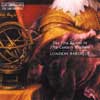(The) Trio Sonata in 17th Century England
Forthright playing from an expert group as they start their Baroque exploration
View record and artist detailsRecord and Artist Details
Composer or Director: Orlando Gibbons, John Coprario, Henry Purcell, John Jenkins, John Blow, William Lawes, Matthew Locke
Genre:
Chamber
Label: BIS
Magazine Review Date: 4/2004
Media Format: CD or Download
Media Runtime: 70
Mastering:
Stereo
DDD
Catalogue Number: BIS-CD1455

Tracks:
| Composition | Artist Credit |
|---|---|
| (9) Fantasias a 3, Movement: No. 6 |
Orlando Gibbons, Composer
London Baroque Orlando Gibbons, Composer |
| (9) Fantasias a 3, Movement: No. 8 |
Orlando Gibbons, Composer
London Baroque Orlando Gibbons, Composer |
| (9) Fantasias a 3, Movement: No. 9 |
Orlando Gibbons, Composer
London Baroque Orlando Gibbons, Composer |
| (8) Fantasia-suites |
John Coprario, Composer
John Coprario, Composer London Baroque |
| (8) Fantasia-Suites, Movement: G minor |
William Lawes, Composer
London Baroque William Lawes, Composer |
| Little Consort: 10 Suites, Movement: D minor |
Matthew Locke, Composer
London Baroque Matthew Locke, Composer |
| Sonata |
John Blow, Composer
John Blow, Composer London Baroque |
| Ground |
John Blow, Composer
John Blow, Composer London Baroque |
| (10) Sonatas in Four Parts, Movement: D |
Henry Purcell, Composer
Henry Purcell, Composer London Baroque |
| Fantasia and Ayre |
John Jenkins, Composer
John Jenkins, Composer London Baroque |
Author: Lindsay Kemp
Having over the years recorded the core trio sonata repertoire in the usual format of single-composer CDs, London Baroque have decided to change tack with this release, the first in an eight-disc series exploring the development of the trio sonata throughout Europe. It means that although names such as Corelli, Purcell, Vivaldi, Leclair and Handel will inevitably be revisited, quite a few rarer but still deserving ones get a look-in, too. Such is the case with this first release, which traces the emergence of the trio sonata in England – although, with only two of the works presented actually calling themselves sonatas, it is probably more accurate to say that what London Baroque are chasing down here are English examples of trio style.
This is how a viol-consort man like Gibbons can sneak in, a group of his three-part fantasias being deemed near enough to the characteristic trio sonata texture of two treble instruments and bass to serve as a starting-point, and from there the selected fantasias and suites follow a satisfying transition to the recognisable violinistic trio style of Blow and Purcell. Along the way are other ‘consort-thinking’ composers such as the bold and lively John Coprario, the emotionally intense William Lawes and the elegant John Jenkins, as well as the more European- and Baroque-inspired Matthew Locke and Christopher Simpson. It is fascinating to be able to compare them, and the musical rewards are substantial too.
London Baroque’s distinctive sound is pretty familiar by now, based as it is on a fluid and vibrant string sound. Mainly heard in high- Baroque repertoire, it is perhaps not what we are used to for the earlier pieces on this disc – no wispy Englishness here, instead gutsy bowing and forthright expression – but it brings intensity and sonic weight to all of the pieces. You have to like it, though; London Baroque rarely relent, and the rather reverberant sound means that for some listeners it may seem a little rich after a while. But even if you only feel able to sample this disc in smallish doses, it should always be a pleasure to hear such an expert ensemble at work in this repertoire.
This is how a viol-consort man like Gibbons can sneak in, a group of his three-part fantasias being deemed near enough to the characteristic trio sonata texture of two treble instruments and bass to serve as a starting-point, and from there the selected fantasias and suites follow a satisfying transition to the recognisable violinistic trio style of Blow and Purcell. Along the way are other ‘consort-thinking’ composers such as the bold and lively John Coprario, the emotionally intense William Lawes and the elegant John Jenkins, as well as the more European- and Baroque-inspired Matthew Locke and Christopher Simpson. It is fascinating to be able to compare them, and the musical rewards are substantial too.
London Baroque’s distinctive sound is pretty familiar by now, based as it is on a fluid and vibrant string sound. Mainly heard in high- Baroque repertoire, it is perhaps not what we are used to for the earlier pieces on this disc – no wispy Englishness here, instead gutsy bowing and forthright expression – but it brings intensity and sonic weight to all of the pieces. You have to like it, though; London Baroque rarely relent, and the rather reverberant sound means that for some listeners it may seem a little rich after a while. But even if you only feel able to sample this disc in smallish doses, it should always be a pleasure to hear such an expert ensemble at work in this repertoire.
Discover the world's largest classical music catalogue with Presto Music.

Gramophone Digital Club
- Digital Edition
- Digital Archive
- Reviews Database
- Full website access
From £8.75 / month
Subscribe
Gramophone Full Club
- Print Edition
- Digital Edition
- Digital Archive
- Reviews Database
- Full website access
From £11.00 / month
Subscribe
If you are a library, university or other organisation that would be interested in an institutional subscription to Gramophone please click here for further information.




